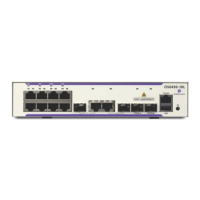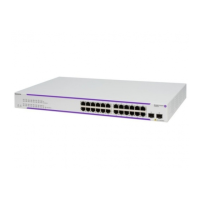OmniSwitch OS6860/OS6900/OS10K Troubleshooting Guide Part No.032996-00 Rev.A
AOS Release 7.X and 8.X January 2015
Alcatel-Lucent Page 100 of 148
OS6860 Hardware Limitations
L3_IPV4_MULTICAST
(L3_ENTRY_2)
L3_IPV6_MULTICAST
(L3_ENTRY_2)
On the ingress side, a single lookup hash table (L3_ENTRY) is used for classifying IPv4 and IPv6 IPMC flows
in addition to storing the IPv4 and IPv6 unicast host entry caches. For example, a single BCM56340 ASIC
could only support the maximum number of IPv6 IPMC forwarding entries if there were no IPv4 or IPv6 host
entries or IPv4 IPMC forwarding entries, which will generally never be the case. Additionally, hash collisions
within the table may prevent the maximum number of entries from being installed in the table.
On the egress side, a single lookup table (L3_IPMC) provides IPMC replication resources for
switching/routing IPv4 and IPv6 IPMC traffic and for Ethernet services like VPLS and PBB.
By aggregating traffic across multiple ASICs, it becomes possible to leverage the ingress classification
abilities of each ASIC to support a larger number of flows than could otherwise be possible with just a single
ASIC. However, the point-to-multipoint nature of IPMC forwarding requires that egress resources be
synchronized in order to support distribution across ASICs. In a Virtual Chassis, the maximum number of
ingress lookup entries for the overall system becomes the sum of the underlying ASICs while the number of
IPMC egress resources remains fixed to the lowest common denominator amongst the ASICs.
OS6900 and OS10K Hardware Limitations
Shared L3_ENTRY table
Hardware entries are shared between IPv4 host table, IPv6 host table, IPv4 multicast and IPv6 multicast. An
ARP entry in the IPv4 host table consumes 1 hash entry. An ND in the IPv6 host table consumes 2 entries. An
IPv4 multicast entry consumes 2 entries and an IPv6 multicast entry consumes 4 entries. For example we can
learn up to 8K IPv4 hosts in the ARP table only if there are no multicast flows classified. The maximum
number or multicast flows is controlled by the MC_CONTROL_5 register using arguments
SHARED_TABLE_L2MC_SIZE and SHARED_TABLE_IPMC_SIZE.
IPMC forwarding index range
Restrict the IPMC forwarding index range to just the reserved indexes:
capability ipmc-max-entry 3
Enabling IPMS
When IPMS is enabled all IP packets matching destination IP address 224.0.0.0/24 are copied to CPU. These
packets are rate limited to avoid CPU flooding. An IGMP Membership Query is broadcasted in all VLANs just
after IPMS is enabled. Example (generated by a switch without any IP interface configured):
MAC: ------ MAC Header ------
MAC:
MAC: Destination Address : 01 00 5E 00 00 01
MAC: Source Address : 00 E0 B1 A6 C0 9C
MAC: Type : 0x0800 (Ethernet II)
MAC:
IP: ------ IP Header -----------
IP:
IP: Version = 04 (0x04)
IP: Header Length = 24 (0x18)
IP: Differentiated Services Field = 192 (0xC0)
IP: Type of Service = 192 (0xC0)
IP: Total Length = 32 (0x0020)
IP: Identification = 4229 (0x1085)
IP: Fragment Offset = 0
IP: Time to Live = 1 (0x01)
IP: Protocol = IGMP
IP: Checksum = 0x…

